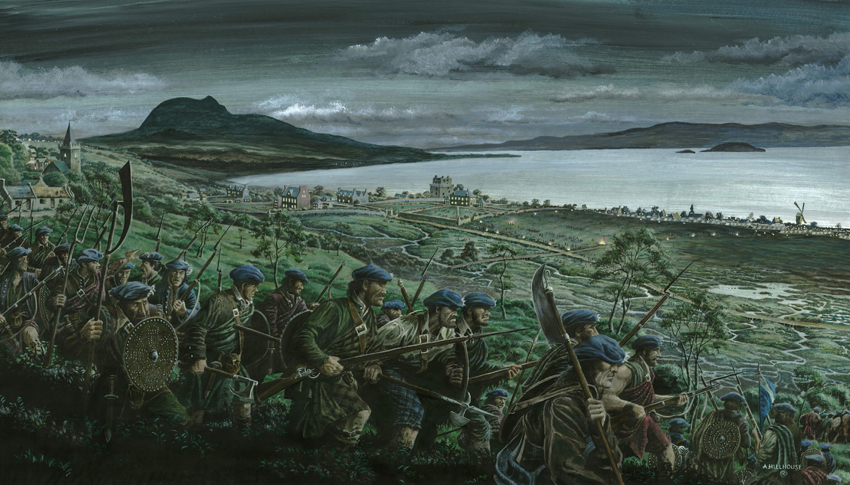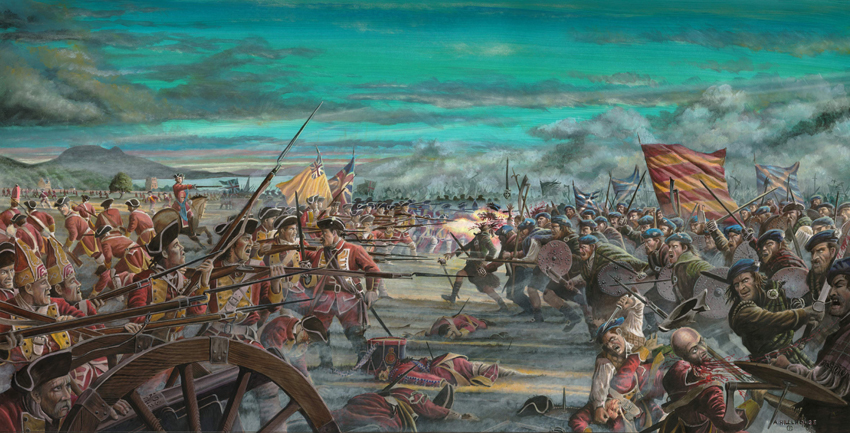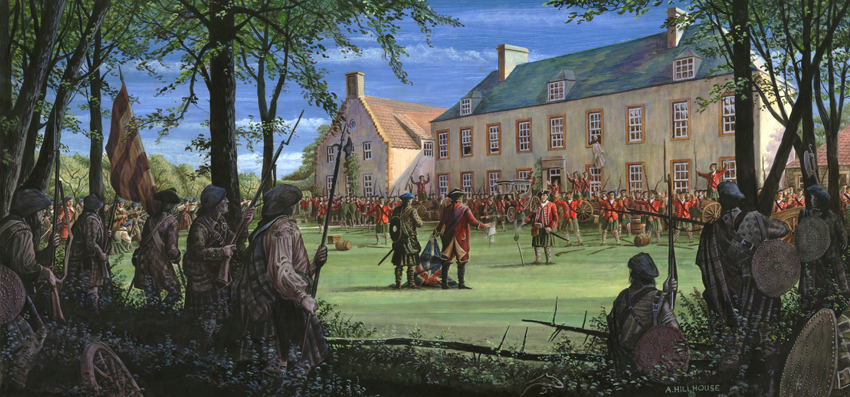The Battle of Prestonpans
The final stage of the campaign began when Sir John Cope led his army out of Dunbar on the morning of 19 September. The Jacobite Army marched eastwards from Edinburgh the following day, ready to intercept him in East Lothian. The two armies finally met in the early afternoon of 20 September, but it would be until the following dawn that the two armies would clash. The video below gives a quick introduction to the battlefield area and the troop movements within it. The timeline underneath provides a little more detail.
Lt-General Sir John Cope marches his army out of the camp at Dunbar, heading west towards Edinburgh. The redcoats cross the river Tyne at East Linton, pass the farm at Beanston, and then establish a camp at Haddington.
19 September
1745
Hearing of the British Army’s march, the Jacobite Army moves to Duddingston. Here Prince holds a Council of War. This determines first that the intention is to fight, then agrees the arrangements for doing so. The Prince insists he will lead the attack in person, but the chiefs insist he must not be exposed to such risk. He agrees therefore to command from the second line.
19 September
The British Army strikes camp and marches west from Haddington. Before reaching Gladsmuir, it turns north down a minor road which leads onto the flatter coastal plain near Longniddry. This is to avoid the enclosures and coal pits on the approach to Tranent. In the hope of better fields of fire on the plain, the redcoats have yielded the higher ground.
20 September, 9am
1745
The Jacobite Army forms its marching column at Duddingston. Before it moves out, the Prince addresses the officers with drawn sword. The words of his speech are repeated to the clansmen, and they march east with eager spirits.
20 September, 9am
The British Army pauses near St Germains. A scouting party comprising the Earl of Home, the Earl of Loudoun, Lt-Colonel Whitefoord and Lord Drummore rides on to Inveresk. There they observe the Jacobite vanguard advancing, sending word back to General Cope.
20 September, 12pm
The Jacobite Army secures the ridge at Birslie Brae, west of Tranent. The Prince has his first sight of the British Army, formed on the open farmland below. The redcoats wheel around to face him, but the marshy ground between them negates the advantage of the heights.
20 September, 1pm
Cope’s army observes strange movements on the ridge, redeploying their battle line several times in response. They interpret this as the Jacobites probing for ways to attack, whereas they are actually becoming increasingly frustrated at not knowing how to break the impasse. The Jacobites secure the area around Tranent Churchyard, and Cope fires upon them with his cannons. The first casualties are taken by the Camerons.
20 September, mid afternoon
The Jacobites have moved into the fields to the east of Tranent, whilst the British soldiers remain on the stubble fields below. Skirmishes from the Atholl Brigade fire on redcoat pickets near Bankton House, fixing their attention on the west. The redcoats make an abortive attempt to fire shells into the resting Jacobites.
20 September, evening
The Jacobite high command assesses information from Robert Anderson of Whitburgh suggesting a pathway down onto the plain. This dry trackway through the marsh would allow the Jacobites to force a battle, but it means they have to abandon the heights and fight on flat open ground against an enemy with greater firepower. The Prince decides it is worth the risk…
20 September, midnight
The Jacobite Army forms into column in the darkness and begins to advance cautiously along the trackway. It passes a narrow defile near the farm of Riggonhead before reaching the plain just before the dawn. They then begin to form their battle-lines.

21 September, 4am
1745
The British Army is alerted to the unexpected approach of the Jacobites from the east. The soldiers spring up from the ground and rush to their positions. The whole army then rapidly moves into a new alignment facing east towards the rising sun.
21 September, 5am
As soon as it is formed and ready, the Jacobite Army advances. Initially it stays in line, but after the British artillery opens fire the Highlanders condense into columns or clusters and move on rapidly. Both sides exchange musket fire, then the Jacobites charge. The artillery crews flee and the British dragoons on both flanks draw back, throwing the line into disorder. The Highlanders fall on and the British army breaks. A general rout follows. Around 50 Jacobites are killed compared to around 400 redcoats. Most of the surviving British infantry are taken prisoner, with only the cavalry managing to escape.

In the hours which follow the battle, there is much work to be done. First, the British army’s baggage had to be secured. The baggage guard, made up of one company of the Black Watch and several (understrength) Highland companies, is persuaded to surrender peacefully through mediation by a captured senior officer. Prisoners are processed and surgeons summoned from Edinburgh to treat the wounded of both sides. Colonel James Gardiner dies of his wounds at around 11am.

21 September, mid-morning
The day after the battle, the Prince returns to Edinburgh after spending the night at Pinkie House. He is piped into the city to the tune of “When the King Enjoys His Own Again”, but forbids an open celebrations of the victory. The Jacobites occupy Edinburgh until 1 November when they begin their march on London.
22 September
1745
A court of inquiry opens at Horse Guards in London, examining the events of the battle and the conduct of Sir John Cope and two other senior officers. Although all three are exonerated, their defeat at Prestonpans proves a lasting stigma.
1 September
1746
Exactly a year since he arrived on Prestonpans Battlefield, Prince Charles Edward Stuart departs Scotland and returns to exile. He has been on the run since his defeat at the Battle of Culloden five bitter months before.
20 September
1746
The first re-enactment of the battle is held at Meadowmill to mark the 250th anniversary.
1995
The Battle of Prestonpans (1745) Heritage Trust is established as a charity to research, interpret and protect the battlefield, reflecting its importance to both local and national heritage.
2006
At a gala dinner at the Palace of Holyroodhouse, the Trust establishes the Alan Breck’s Regiment, which now runs 1745 living history events across the country.
The Trust holds its first battle re-enactment weekend.
2007
Martin Marguiles became Colonel-in-Chief of the Alan Breck Regiment of Prestonpans Volunteers, which regiment has responsibility for annual re-enactments each September
2008
Prestonpans Battlefield is designated as a nationally significant landscape in the Scottish Government’s new Inventory of Historic Battlefields.
2009
The now famous Prestonpans Tapestry is completed and enjoys its debut tour at community exhibitions across the route of the 1745 campaign.
2010
Challenges facing battlefields across Scotland lead to the Trust calling a special symposium in Prestonpans Community Centre. The result is the signing of the Scottish Battlefields Accord, and the establishment the following year of the Scottish Battlefields Trust.
2014
The Trust secures leases on the Colonel Gardiner Monument, the Viewpoint summit, and Bankton Doocot. The latter is renovated and re-opened to the public, telling within the story of James Gardiner and his role in the battle.
2017
The Trust unveils two new stone monuments on the battlefield, in honour of the fallen soldiers from the two armies. The Jacobite memorial was dedicated by a gathering of clan chiefs and representatives; the British army memorial by the Governor of Edinburgh Castle.
2018
The 275th anniversary of the battle is commemorated against the backdrop of a global pandemic, marked by a special programme of events and exhibitions running through 2020-2021.
2020
A dedicated visitor centre opens with the mission of bringing to life the story of the battle and inspiring future generations to continue its lasting cultural legacy….
The future?